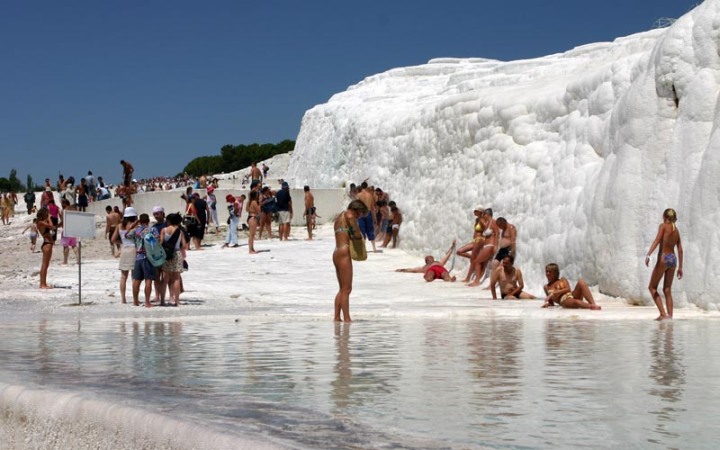Date of Inscription to the World Heritage List: 9.12.1988
List Reference: 485 Criteria: Natural/ Cultural
SACRED LAND CLAD IN WHITE
According to the legend that spread the mystery of Hierapolis to the wide world, an ugly shepherd girl, fed up with the burdens of life, cast herself into water, but turned into a beautiful maiden in the waters of Hierapolis.
Hierapolis was founded during the Phrygian era, and its name was derived from Hiera, the beautiful wife of Telephos, the King of Pergamon. Hierapolis played an important role in spreading Christianity in Asia Minor, and it was the place where Phillip, one of the twelve Apostles of Jesus Christ, died. For this reason, Hierapolis became an important religious centre in the 4th century AD. Later it assumed the title of the Guide of the East and saw its most brilliant years between 96 and 162 AD. Hierapolis came under Byzantine rule in 395, and became a metropolitan bishopric.
History and nature meets in an extraordinary manner at Pamukkale. The name Hierapolis also means the sacred city. It has the Necropolis, the Domitian Road and gate, the temple of Plutonium set in a square area, the theatre with reliefs depicting the mythology of Apollo and Artemis, the Frontinus street and Gate, the Agora, the North Byzantine Gate, the South Byzantine Gate, the Gymnasium, The Fountain with Triton, the House with Ionic capitals, the Apollo sacred site, the aqueducts and Nympheum, the city walls, the Martyrium of St. Phillip and bridge, the Column Church, the ruins of Basilica and Roman Baths. These are still standing in all their glory.
The Pamukkale travertine was created by thermal water depositing the calcium carbonate it contained. The natural wonder of Pamukkale travertine deposits span a 160 metres tall and 2700 metres long cascade. With its brilliant white colour, it can be seen about a distance of 20 km. At Pamukkale there are 17 thermal springs with water temperatures between 35-100-C.
The thermal mineral water springs and exceptional scenery have impressed people since antiquity. Wealthy people came from Rome and other cities of Anatolia to spend their last years in Hierapolis. Because of this, the Necropolis (the grave yard) is full of monumental tombs decorated in the styles of different regions.
The historical artefacts found in the excavations are on display at the Archaeology Museum of Hierapolis. The Tripolis antic city in Buldan County and Colossea antic settlement in Hozanz County are the most important of all antic settlements In the region.
This sacred land clad in white is waiting for those who want to heal in its waters with a natural therapy.
The post Hierapolis – Pamukkale appeared first on Turkey Travel Guide and Touristic Regions information.























